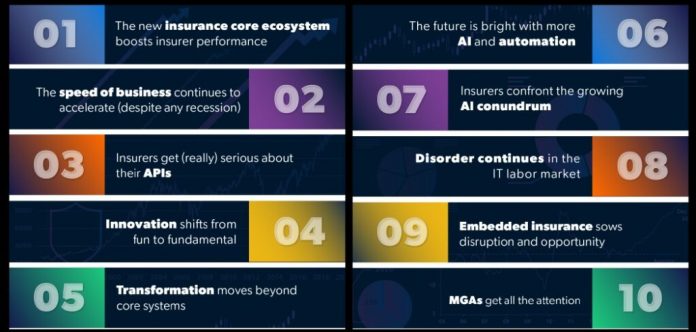[ad_1]
By Martina Conlon, Head of P&C Insurance coverage Observe, Aite-Novarica Group —
Insurance coverage has historically been considered as resilient to recession and financial uncertainty. But, apart from the robust financial circumstances, the insurance coverage business is going through an unprecedented variety of enterprise challenges: growing claims severity charges because of provide chain points and rising inflation, local weather threat and ever extra frequent pure catastrophes, elevated regulatory oversight, and higher buyer expectations.
Usually, in a tough atmosphere, insurers can be tightening their belts, but in 2023, Aite-Novarica Group anticipates many insurers taking a special strategy by growing funding in IT and implementing new applied sciences to enhance operational efficiencies, improve income, and improve buyer expertise.
Listed below are a number of the prime traits Aite-Novarica Group sees dominating the property/casualty house in 2023:
- The brand new insurance coverage core ecosystem will develop. Insurers typically establish level options with use instances throughout their group however lack the sources essential to combine with so many in parallel. Core system expertise suppliers are increasing their “hubs” or “marketplaces” for preintegrated and authorized third-party purposes that add worth to an insurer’s resolution and permit them to compete in immediately’s market.
- Velocity of enterprise will proceed to speed up regardless of a recession. Aggressive pressures on insurers imply that slowing down on strategic IT supply isn’t an choice, and insurers will likely be anticipated to search out expense discount whereas persevering with to speed up the tempo of expertise supply.
- Transformation will transfer past core programs. As many insurers’ core modernization tasks conclude, transformational efforts are shifting to the following spherical of enterprise capabilities to be optimized and revolutionized. Ongoing income and expense pressures, coupled with expertise shortages, are pushing insurers to search for operational effectivity positive factors throughout the enterprise.
- Innovation will shift from pastime to aggressive benefit. The pandemic and different evolving adjustments resembling local weather threat, provide chain disruption, and unstable international economies have pushed insurers to embrace innovation. New applied sciences will turn into a vital ingredient of an insurer’s skill to remain forward of future disruption and altering market circumstances.
- There’s a rising AI conundrum. As insurers develop their adoption of AI, they should deal with forthcoming rules and tackle potential mannequin bias. Insurers could start to implement AI threat administration applications to observe and perceive selections made by AI fashions and guarantee equity and transparency.
To study the remainder of the highest 10 traits Aite-Novarica Group foresees impacting the property/casualty market in 2023, please register for our webinar on February 9: High 10 Developments in P/C Insurance coverage, 2023: Turning Disruption into Alternatives. When you can’t make it, you’ll be able to examine these areas of the business in our report, High 10 Developments in Property/Casualty, 2023: Turning Disruption into Alternatives or attain out to me at [email protected].
About Aite-Novarica Group
Aite-Novarica Group is an advisory agency offering mission-critical insights on expertise, rules, technique, and operations to tons of of banks, insurers, funds suppliers, and funding companies—in addition to the expertise and repair suppliers that help them. Comprising former senior expertise, technique, and operations executives in addition to skilled researchers and consultants, our consultants present actionable recommendation to our consumer base, leveraging deep insights developed through our intensive community of shoppers and different business contacts. For extra info, go to aite-novarica.com.
Supply: Aite-Novarica Group
Tags: Aite-Novarica Group, carriers, Property/Casualty (P&C) insurance coverage, Strategic Funding, expertise funding
[ad_2]
Source_link






